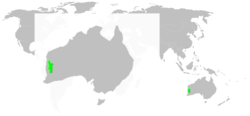Idiosoma nigrum
| Idiosoma nigrum | |
|---|---|
| Scientific classification | |
| Kingdom: | Animalia |
| Phylum: | Arthropoda |
| Class: | Arachnida |
| Order: | Araneae |
| Suborder: | Araneomorphae |
| Family: | Idiopidae |
| Genus: | Idiosoma |
| Species: | I. nigrum |
| Binomial name | |
| Idiosoma nigrum Main, 1952 | |
 | |
Idiosoma nigrum, also called Black rugose trapdoor spider, occurs only in south-western Australia, in dry woodlands east of the Darling Scarp and north to Moore River.
Females can reach a length of about 30mm, males about 18mm.
I. nigrum digs burrows up to 32 cm deep.
Name
The species name is derived from Latin Niger "black".
Biology
The Black Rugose Trapdoor Spider is adapted for life in semi-arid habitats. They live in burrows up to 32 cm deep.[1] These spiders construct an arrangement of leaves and twigs radiating out from the burrow entrance to serve as remote sensing device - any movement alerts the spider to the presence of prey.[1] Rather than foraging only at the burrow mouth (as many other trapdoor spiders do), these spiders charge out to grab animals on the trip-lines - especially ants, but also beetles, cockroaches, millipedes and moths. This twig-line feeding strategy increases the spider's foraging area and its chances of catching food.
The rugose spider has a thickened cuticle which serves as an effective armor.[1] A few centimeters below its thin, wafer-like door, the vertical burrow narrows abruptly. When threatened by a predators the spider drops head-down into this narrowed section, phragmotically plugging it with the shield-like abdomen. Confronted by this, predators like scorpions, centipedes, hunting wasps and even birds, often give up and go away. However, this defense has been breached by certain parasitic wasps that can maneuver their paper-thin abdomens and long, slender egg-laying tubes (ovipositors) down along the grooves on the spider's abdomen, allowing their eggs to be laid on the softer cuticle at the front of the abdomen. The wasp larva that emerges is difficult for the spider to dislodge from that area and it can safely start devouring its victim alive.[1]
The thick cuticle also prevent against water loss through evaporation.[1]
During autumn, the smaller, long-legged male spiders (up to 18 mm body length) look for females. Mating takes place in the female's burrow. Eggs are laid during late spring and early summer and the young emerge from the egg sac in mid-summer. They remain in the mother's burrow until early winter, when rainstorms moisten and soften the ground. This ensures that the young dispersing on the ground are not going to suffer excessive water loss and will be able to dig their burrows.[1]
References
- 1 2 3 4 5 6 "Black Rugose Trapdoor Spider factsheet". Australian Museum Online. Retrieved 2006-08-17. External link in
|work=(help)
External links
![]() Data related to Idiosoma nigrum at Wikispecies
Data related to Idiosoma nigrum at Wikispecies
- More information and pictures
- The World Spider Catalog, V8.0 Idiopidae